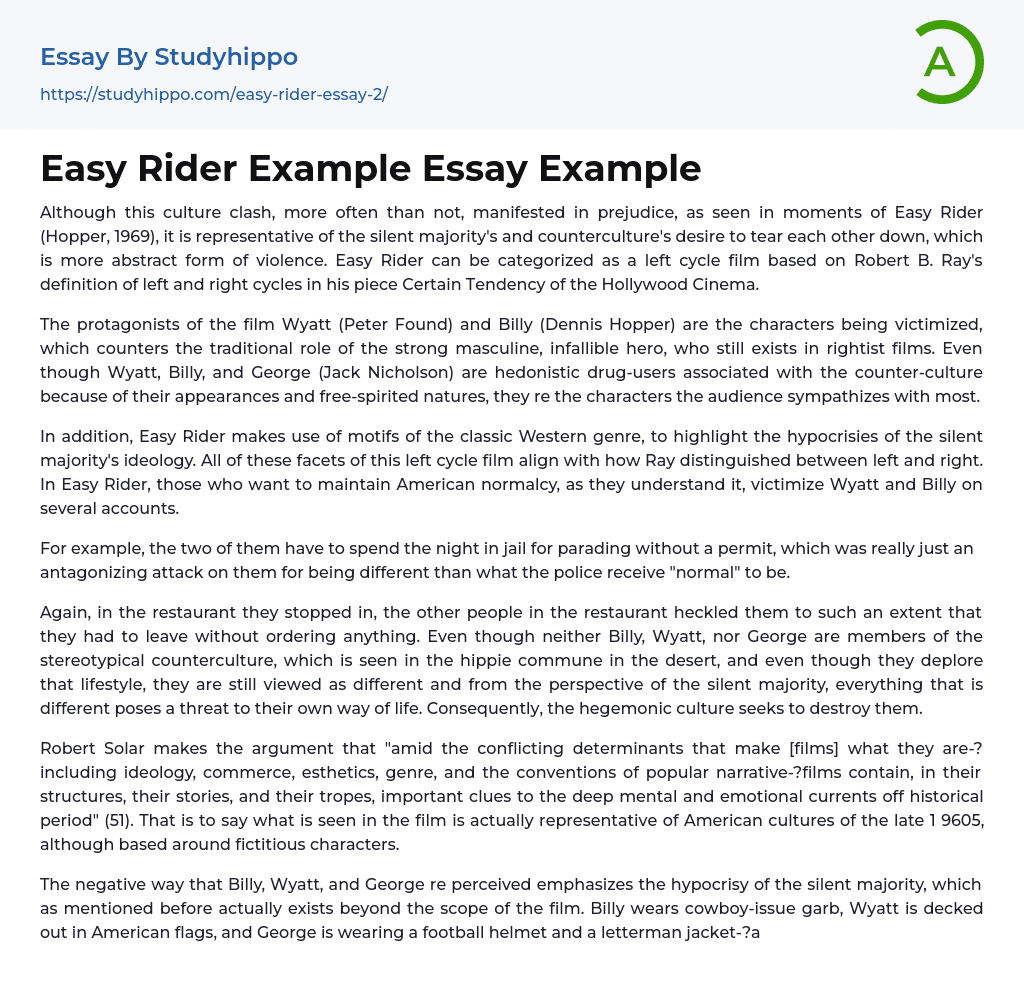Although this culture clash, more often than not, manifested in prejudice, as seen in moments of Easy Rider (Hopper, 1969), it is representative of the silent majority's and counterculture's desire to tear each other down, which is more abstract form of violence. Easy Rider can be categorized as a left cycle film based on Robert B. Ray's definition of left and right cycles in his piece Certain Tendency of the Hollywood Cinema.
The protagonists of the film Wyatt (Peter Found) and Billy (Dennis Hopper) are the characters being victimized, which counters the traditional role of the strong masculine, infallible hero, who still exists in rightist films. Even though Wyatt, Billy, and George (Jack Nicholson) are hedonistic drug-users associated with the counter-culture because of their appearances and free-spirited natures, they re the c
...haracters the audience sympathizes with most.
In addition, Easy Rider makes use of motifs of the classic Western genre, to highlight the hypocrisies of the silent majority's ideology. All of these facets of this left cycle film align with how Ray distinguished between left and right. In Easy Rider, those who want to maintain American normalcy, as they understand it, victimize Wyatt and Billy on several accounts.
For example, the two of them have to spend the night in jail for parading without a permit, which was really just an antagonizing attack on them for being different than what the police receive "normal" to be.
Again, in the restaurant they stopped in, the other people in the restaurant heckled them to such an extent that they had to leave without ordering anything. Even though neither Billy, Wyatt, nor George are members of th
stereotypical counterculture, which is seen in the hippie commune in the desert, and even though they deplore that lifestyle, they are still viewed as different and from the perspective of the silent majority, everything that is different poses a threat to their own way of life. Consequently, the hegemonic culture seeks to destroy them.
Robert Solar makes the argument that "amid the conflicting determinants that make [films] what they are-?including ideology, commerce, esthetics, genre, and the conventions of popular narrative-?films contain, in their structures, their stories, and their tropes, important clues to the deep mental and emotional currents off historical period" (51). That is to say what is seen in the film is actually representative of American cultures of the late 1 9605, although based around fictitious characters.
The negative way that Billy, Wyatt, and George re perceived emphasizes the hypocrisy of the silent majority, which as mentioned before actually exists beyond the scope of the film. Billy wears cowboy-issue garb, Wyatt is decked out in American flags, and George is wearing a football helmet and a letterman jacket-?all items that are symbolic of America. The travelers embody the American ideal of complete unrestrained freedom and the desire to fulfill the Turner Thesis. According to Joe B.
Lawrence, 'the Turner Thesis interpreted the American westward movement as a compulsive search for untrimmed freedom, and the West embodied the ideal of rugged individualism untainted by restrictive laws or prissy social conventions" (665). Nonetheless, they are rejected by the silent majority, which ironically continues to idealize Americana, the cowboy, and freedom; yet, the silent majority enforces restrictive laws and prissy social conventions to coo interact the physical
embodiment of the traditional American ideals and acts as "the antithesis of the concept of Western freedom" (Lawrence 665).
This rejection of the embodiment of traditional American ideals and the will to destroy those who do complicates the binary f left and right. Superficially, the left and the right appear to be polarize, but that is not actually the case. There is a huge overlap of ideals in regards to freedom.
In Easy Rider, George says, 'They re goanna talk to you, and talk to you, and talk to you about individual freedom, but they see a free individual, it's goanna scare 'me. The conflict originates not from a difference in ideals, as it would seem. On the contrary, the conflict between the silent majority and the counterculture arises from ceasing to idealize freedom and actually going n search of it and actually acting on the individual freedoms that Americans are promised. It is people who take this step that the silent majority antagonizes and rejects out of fear.
When people engage in unbridled freedom, the consequences are unprecedented and the not knowing of what could happen is what instills dread in the hegemonic culture because there is security in keeping things as they are.
When the silent majority's fear is confronted with the counterculture's desire for true freedom, it results in animosity and the desire to destroy the other and ultimately a violent, yet ironic, cultural war. Works Cited Easy Rider. Dir. Dennis Hopper.
- Business Law essays
- Contract essays
- Consumer Protection essays
- Property essays
- Ownership essays
- Agreement essays
- Common Law essays
- Contract Law essays
- Justice essays
- Security essays
- Tort Law essays
- United States Constitution essays
- Crime essays
- Lawsuit essays
- Treaty essays
- Family Law essays
- Marijuana Legalization essays
- Constitution essays
- War on Drugs essays
- Court essays
- Jury essays
- Police essays
- Protection essays
- Community Policing essays
- Criminal Law essays
- Judge essays
- Lawyer essays
- Employment Law essays
- Copyright Infringement essays
- Injustice essays
- Intellectual Property essays
- Breach Of Contract essays
- Jurisprudence essays
- Social Injustice essays
- Juvenile Justice essays
- Internet Privacy essays
- Cyber Security essays
- Bill Of Rights essays
- Civil Liberties essays
- First Amendment To The United States Constitution essays
- Fourth Amendment To The United States Constitution essays
- Second amendment essays
- Animal Cruelty essays
- Law Enforcement essays
- Juvenile Justice System essays
- Surveillance essays
- Forensic Science essays
- Crime Prevention essays
- Criminal Justice essays
- Criminology essays




